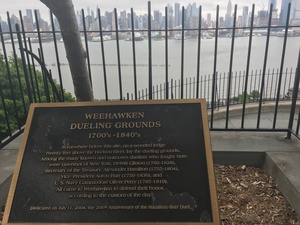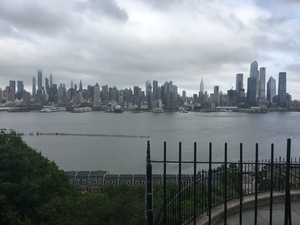The Weehawken Dueling Grounds is a place where dueling was done between 1700 and 1884. It is located below the cliffs of the New Jersey Palisades, right next to the Hudson River. There were at least 18 known duels to occur there between 1700 and 1884, but is most famously known for the duel between Alexander Hamilton and Aaron Burr in 1804.
The Burr–Hamilton duel is one of the most famous personal conflicts in American history. It was a pistol duel which arose from long-standing personal bitterness that developed between the two men over the course of several years. These tensions grew throughout the years until they faced each other in the gubernatorial election in New York in 1804, when both Hamilton and Burr were running for governor. Throughout their campaigns, Hamilton was in the press defaming Burr’s character so he could have an easier time winner the election. This increased tensions for the election to the point where they decided they needed to duel. An interesting coincidence, Hamilton’s son Phillip was killed in a duel at the same place three years prior in 1801.
At the time, dueling was illegal in the northern United States, but was still done in secret. Not only was it illegal to duel at the time, it also had large ramifications politically if citizens had found out about it. Due to these precautions, it was known that authorities in New Jersey were less strict with crimes like this, so they decided to duel in New Jersey. They both crossed the Hudson River into New Jersey early in the morning on separate boats. The guns used in the duel were sent to the grounds on separate boats, so witnesses could say they saw no weapons; and reportedly, witness had their backs to the duel so they could deny they saw it happen.
In dueling culture in the 18th and 19th century, it was common to shoot at the ground right at the other’s feet, to show courage and that the duel would end peacefully. This was not the case for this duel. Supposedly Hamilton shot above Burr’s head first, and Burr returned fire hitting Hamilton in the ribs. Burr was rushed away by his team, and Hamilton was rushed to the home of William Bayard Jr, where he died the next day. Burr survived the duel and was indicted for murder in both New York and New Jersey, though these charges were later either dismissed or resulted in acquittal. The harsh criticism and animosity directed toward Burr following the duel brought an end to his political career. The Federalist Party was already weakened by the defeat of John Adams in the presidential election of 1800 and was further weakened by Hamilton's death. After this duel, there was a strong push among the people and government to finally put an end to dueling, which did happen, as there were no duels at the Weehawken grounds after the fateful Burr-Hamilton duel.
The duel was the final skirmish of a long conflict between Democratic-Republicans and Federalists. The conflict began in 1791 when Burr won a United States Senate seat from Philip Schuyler, Hamilton's father-in-law, who would have supported Federalist policies. (Hamilton was the Secretary of the Treasury at the time.) The Electoral College then deadlocked in the election of 1800, during which Hamilton's maneuvering in the House of Representatives caused Thomas Jefferson to be named president and Burr vice-president.
Today, there are plaques, and a bust of Hamilton above the grounds where the duel took place where they commemorate Hamilton as well as his son, and describe the incident that took place there. There is also a very beautiful park, which overlooks the Manhattan skyline.






